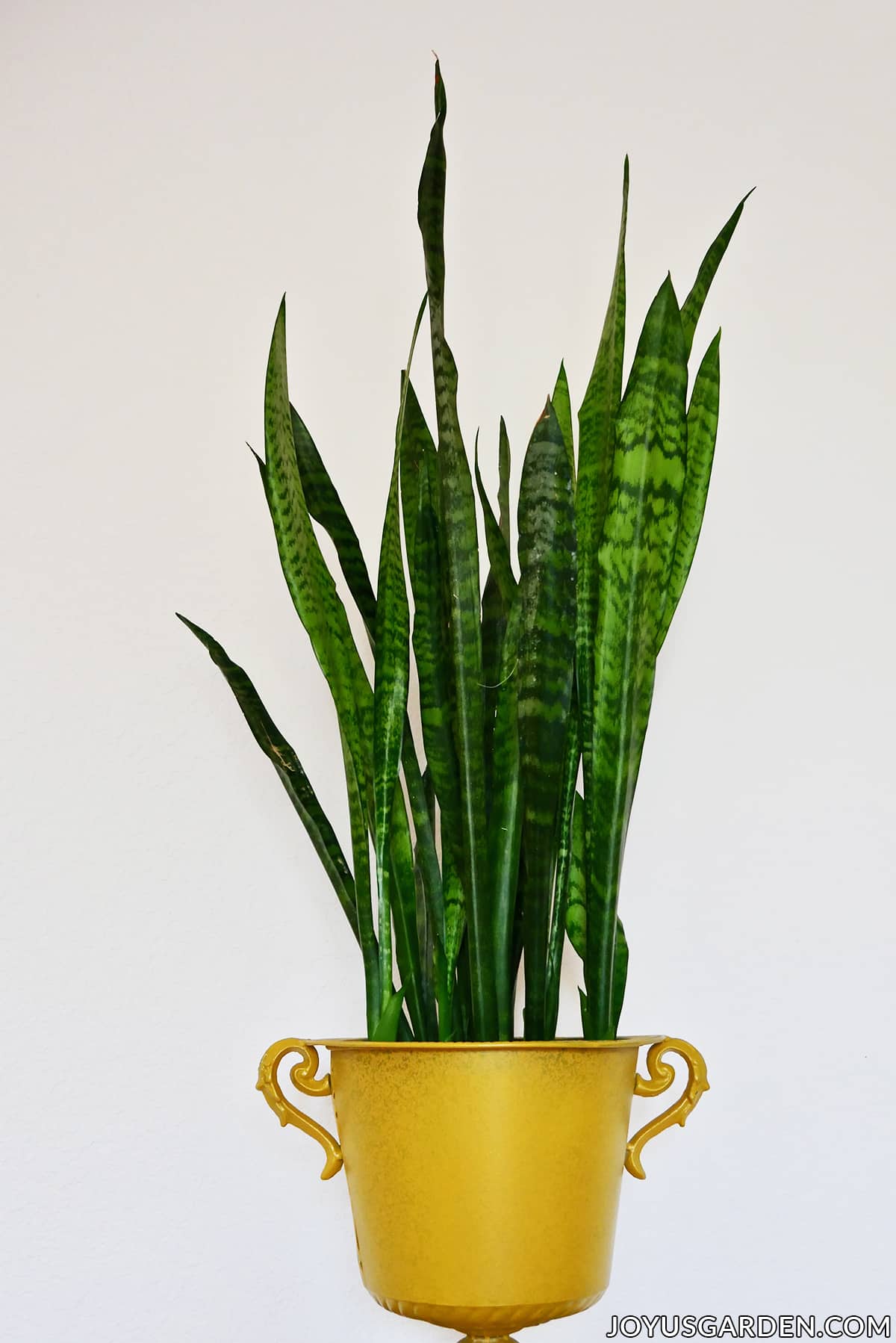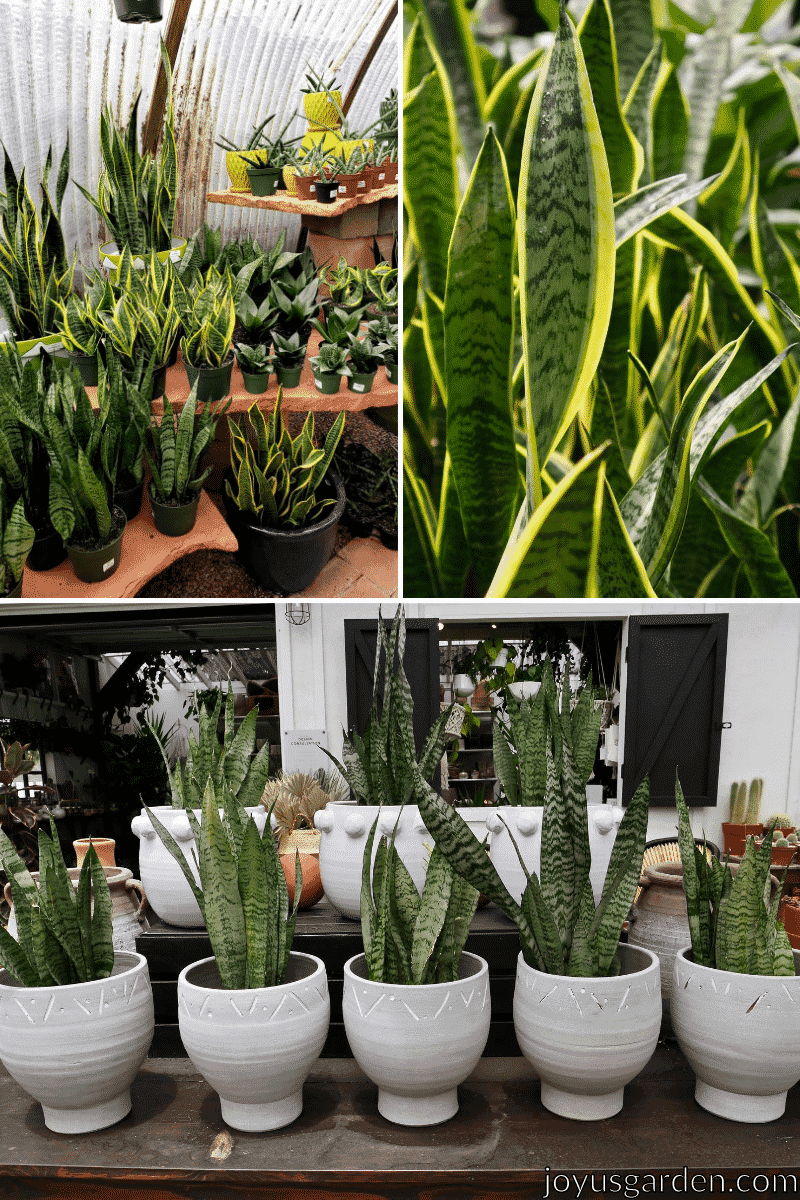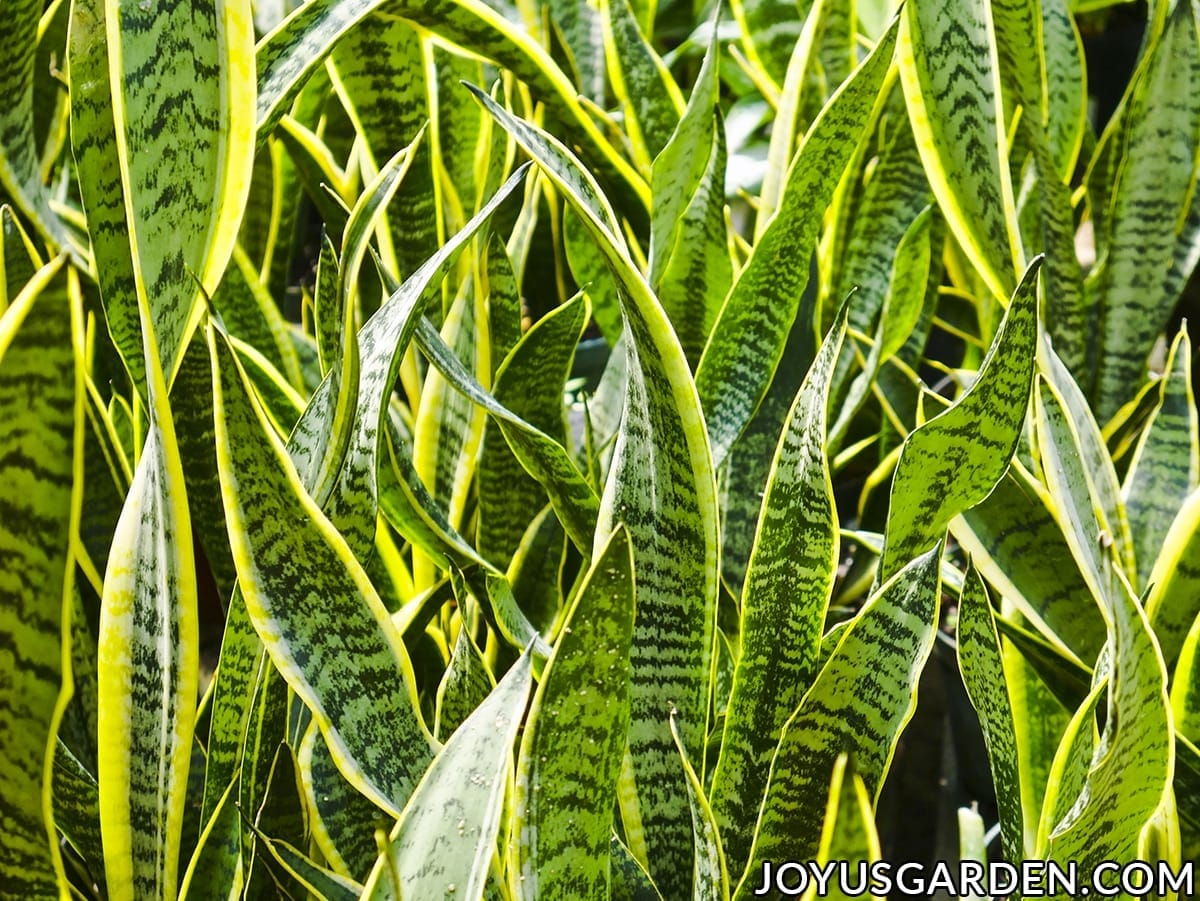
Sansevierias (now Dracaenas) are popular & easy-care houseplants. Here you’ll find Snake Plant Care tips, including things good to know to keep yours growing.
You are watching: Snake Plant Care: How to Grow this Diehard Houseplant
Snake Plants are some of the toughest plants you can find. Whether indoors, in your garden, or on your balcony, these spiky beauties can put up with almost anything. They’re easy to grow, but you should know a few things. Keep reading for Snake Plant care tips as a houseplant – you’ll see how low maintenance they really are.
Snake Plant Traits

Botanical Name: Dracaena spp & varieties (this plant has recently been reclassified from the Sansevieria genus to the Dracaena genus, but most still call them Sansevierias, so I will, too, for now).
Common Name: Snake Plant, Mother-In-Law’s Tongue.
Everyone doesn’t swoon over these plants because of their strong, bold look and tough sword-like leaves. They’re definitely not the soft, “touchy-feely” kind of plants but certainly have character and interest and present quite the striking silhouette.
Their modern, edgy feel appeals to me, along with how easy they are to care for. I now live in Tucson, Arizona, where I have them growing in my home and a couple in pots outside in the bright shade on my covered patio. The strong desert sun will fry them, but they handle the dry air like champs.
These evergreen perennials are very long-lived, unlike some houseplants. If you’re looking for your own Snake Plant, many different species and varieties are on the market, with more new ones being introduced each year.
You can find them tall or short, with round, flat, or concave leaves, and solid or variegated foliage with dark green, silver, light green, yellow, chartreuse, or white.
My personal favorites are the old standbys Dracaena trifasciata and laurentii, zeylanica, cylindrica (this is the one they braid), moonshine, futura superba, jade, gold star, and bonsal. The latter three stay small and are suited for small spaces.
Size
Snake Plants grown as houseplants average in height from 8″ to 9′. My Sansevieria Zeylanica that you see in the image above is now over 5′ tall. You can buy them in 4, 6, 8, 10, 12, and 14″ grow pots.
Growth Rate
Sansevierias are generally slow growers. They spread by underground stems called rhizomes which pop up as new growth.
In stronger natural light, they’ll grow faster and slower in lower light.
Uses
They’re used as tabletop and narrow floor plants, as well as in dish gardens and kokedama.
Snake Plant Care Guide

Snake Plant Light Requirements
Even though Sansevierias prefer medium light (about 10′ away from the west or south window), they’ll also tolerate lower and higher light levels. How versatile they are!
Just be sure to keep Snake Plants out of the direct, hot sun (not in a west or south window) because they’ll burn in a heartbeat. Indirect sunlight is their sweet spot.
Note: In lower light conditions, the darker-leafed species and varieties ( like D. trifasciata & D. hanhnii jade) do better and are the ones you should buy. Snake Plants with brighter variegations will lose color and become less patterned in low light.
Snake Plant Watering
Easy does it with the watering frequency – this succulent plant doesn’t need it as much as many of your other houseplants. Be careful not to overdo it because too much water often leads to root rot.
Always make sure the soil is almost completely dry before thoroughly watering again. So, if you travel or tend to ignore plants, this plant that thrives on infrequent watering is for you.
How often should I water my Snake Plants? Good question! Water your Snake Plants every two-eight weeks. Your watering schedule will vary depending on your home’s environment, type of soil mix, and pot size. For instance, new plants in small pots will need watering more often than larger, established ones.
I water my Snake Plants less often in the winter months (every five to seven weeks for those in large pots) when the temps are cooler, and the sun is less intense. This is the time of year when houseplants like to rest, and their growth slows. I water my small Snake Plants in 4″ pots every two weeks in summer and every two to three weeks in winter.
Read more : How Much Does It Cost to Build an Outdoor Brick Pizza Oven?
Be sure not to let water build up in the center of the leaves (where they form a cup) because this can lead to a mushy plant and ultimately rot.
You can read my Guide to Watering Indoor Plants to understand better how often to water.

Humidity Levels
These plants don’t mind our homes and offices’ sometimes dry or stale air. They do fine with average household humidity levels.
They’ll also do well in bathrooms where the humidity tends to be much higher and in my home in the desert where the levels are often low. Another versatility factor gives this houseplant the label: “diehard.”
Temperature
As I say regarding houseplants: if your house is comfortable temperature-wise for you, then your Snake Plants will do just fine. You want to avoid putting them in areas with cold or hot drafts.
They tolerate a wide range of temperatures. I have a couple of pots growing outdoors (in the shade) that do fine. We get very hot here in the desert in the summer (110F), and a handful of evenings can dip below freezing in the winter.
If yours is outdoors for the summer (make sure it’s protected from direct, full sun), know they don’t tolerate frost or snow. Get them indoors before the temperatures drop too low.
Fertilizing Snake Plants
Spring and summer are the best times to fertilize your plants. Early fall is fine, too, if you’re in a temperate climate.
We have a long growing season here in Tucson from mid-February through October. I fertilize with Maxsea or Sea Grow, Grow Big, and Liquid Kelp seven times during the growing season. It’s how I feed all my tropical plants. I alternate using these granular and liquid fertilizers and don’t mix them.
I feed them with a topping of worm compost and compost every two or three springs. I give them a light application of worm compost with a light layer of compost over that. Easy does it – a 1/4 ” layer of each for a 6″ houseplant is fine.
Snake Plants aren’t that needy, and fertilizing too often will do more harm than good. Depending on your climate zone, feeding two or three times a year may do it for your indoor plants.
Whatever houseplant food you choose, don’t use more than the recommended amount because salts build up and can burn the plant’s roots. Combined with fertilizing too often, this will show up as brown spots on the leaves.
You want to avoid fertilizing any stressed houseplant, i.e., bone dry or soaking wet. I don’t fertilize houseplants in late fall and winter because it’s not their active growing season.
Snake Plant Soil
Snake Plants are easygoing with their soil requirements. Because root rot is one of the main issues that kill these plants, I’d recommend using fast and well-draining soil to help prevent this.
I use succulent and cactus mix combined with potting soil in a ratio of 1:1 for all of my Snake Plants. I make my own DIY Succulent & Cactus Mix, which I use for all my succulents indoors and outdoors.
If whatever potting mix you’re using seems too heavy, add a few handfuls of pumice or perlite to up the ante on the aeration and drainage factor. This also is beneficial if the pot only has one or two smaller-sized drain holes.
Repotting
You don’t need to rush to repot your Snake Plants. They do better when slightly pot-bound. They have tough root systems, and I’ve seen quite a few that have broken their plastic grow pots. Yes, the rhizomes and roots are that tough.
Generally, I repot mine every three to seven years at the most. If yours is in low light and not growing much, transplanting every five to ten years will probably be fine. It’ll certainly appreciate fresh soil mix at some point!
Just make sure the potting mix you use is well-draining and there’s at least one drainage hole on the bottom of the pot so the excess water can flow out.
Here’s a post dedicated to repotting Snake Plants: Repotting Snake Plants: the Soil Mix to Use & How to Do it.
Pests
Snake Plants are relatively pest-resistant, but in poor conditions, they may occasionally attract mealybugs or spider mites.
Read more : Cold food? Party foul! Expert tricks to keep food perfectly warm for a party.
If yours gets mealybugs, I’ve got you covered with this post on How to Get Rid of Mealybugs on Plants. Here you can find info on Spider Mites Control.
Regularly inspect your plant for any signs of infestation and treat accordingly using insecticidal soap, neem oil, or a DIY spray.
It’s best to take action as soon as you see any pest because they multiply like crazy. Pests can travel from houseplant to houseplant fast, so make you get them under control as soon as you see them.
Cleaning Your Snake Plant
My Snake Plants don’t get dusty too often, but I take a damp cloth and wipe off the leaves when they do. It keeps them healthy and makes them look much snazzier.

Propagating Snake Plants
Once you’ve got a Snake Plant, you may never need to buy another one. They’re very easy to propagate. When growing in the garden, they’ll propagate on their own as they spread by underground stems called rhizomes.
As a houseplant, division followed by leaf cuttings are the easiest ways to get new Snake Plants. You can cut off healthy leaf-cuttings and place them in a loose soil mix until they establish roots.
A faster way to propagate is by dividing or removing the offsets (pups, babies) from the mother plant. These can also be put in the same type of soil, and viola, you have a new plant!
Check out these three ways to Propagate Sansevierias and this post on Propagating Snake Plants from Leaf Cuttings.
Safe For Pets
My cats have never chewed on my Sansevieras, indoors or out. The leaves are tough, so I imagine they’re less appealing than a crunchy Spider Plant.
Snake Plants are mildly toxic to cats and dogs. I consult the ASPCA website for my info on this subject and see in what way the plant is toxic.
Most houseplants are toxic to pets in some way. Regarding this topic, do a little more research and come to your own conclusion.
Snake Plant Flowers
Yes, they do but don’t hold your breath waiting for the flowers to appear when grown indoors. This occurrence is relatively infrequent and appears to be rather hit or miss. One of the varieties of Snake Plants growing in my garden in Santa Barbara would flower almost every year, but the others wouldn’t.
The flower of a Snake Plant exhibits a pale whitish to greenish hue and emits a delightful, sweet fragrance.
Snake Plant Care Video Guide
Snake Plant Care FAQs

Are you a beginning houseplant gardener? Be sure to put one or two Sansevieria plants on your want list. You’ll soon find out Snake Plant care is a breeze!
Snake Plants make great office plants because they handle dry air better than most houseplants and don’t need much attention. I’ve seen this hardy plant in long planters at airports and office lobbies, tough environments indeed.
If you’re looking for Snake Plants, a couple that might appeal to you: Sansevieria Zeylanica and Sansevieria Laurentii.
Here are some more sources: Stores Where You Can Buy Indoor Plants Online
To Sum It Up: Snake Plants are virtually indestructible unless you have a heavy hand with the watering can or place them in a hot, sunny window. They seem to thrive on the dry air in our homes and neglect. The more you ignore them, the better they seem to do.
I love Snake Plants because of their bold, architectural, sassy look. There are so many species and varieties to choose from. You’ll be hooked too!
Note: This was originally published on 5/6/2017. It was updated on 3/27/2020 & again on 8/17/2023.
Happy gardening,

This post may contain affiliate links. You can read our policies here. Your cost for the products will be no higher but Joy Us garden receives a small commission. Thank you for helping us spread the word & make the world a more beautiful place!
Source: https://gardencourte.com
Categories: Outdoor


